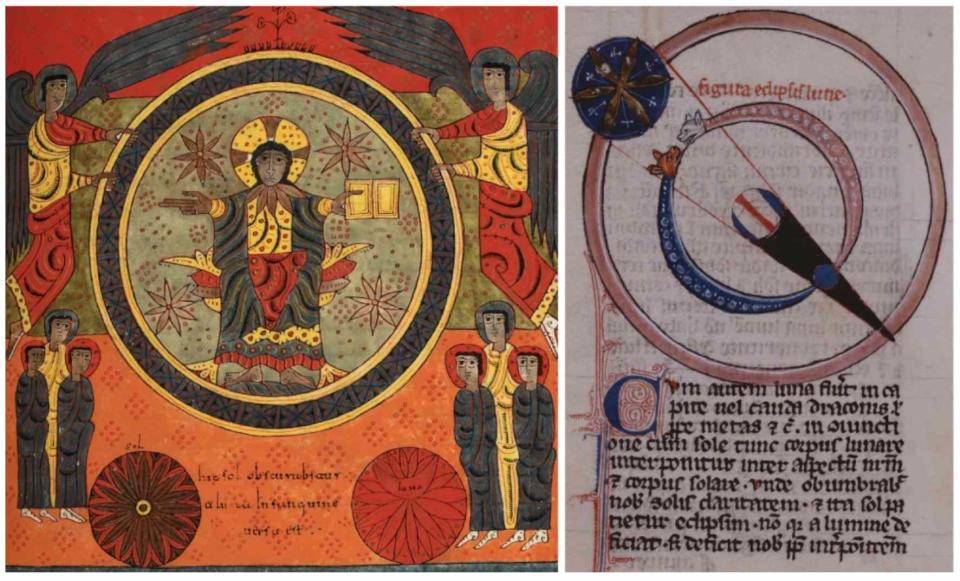Sky-Gazing Medieval Monks Shed Light on Volcanic Mysteries
By observing the night sky, medieval monks accidentally recorded some of history’s largest volcanic eruptions.

British Library Board / The New York Public Library
See bottom of article for detailed descriptions.One day, researcher Sébastien Guillet was listening to Pink Floyd’s album, Dark Side of the Moon, as one does. But rather than trippy reverie, Guillet, a senior research associate at the Institute for environmental sciences at the University of Geneva (UNIGE), had an epiphany. He connected sky-gazing medieval monks’ records of the brightness and color of the eclipsed moon with volcanic gloom.
"I realized that the darkest lunar eclipses all occurred within a year or so of major volcanic eruptions," he recounts. "Since we know the exact days of the eclipses, it opened the possibility of using the sightings to narrow down when the eruptions must have happened.”
Which is how an international team of researchers ended up drawing on readings of 12th and 13th-century European and Middle Eastern chronicles to date some of the biggest volcanic eruptions known to humankind.
Led by UNIGE, the findings reveal new information about one of the most volcanically active periods in Earth’s history.
As explained by the university in a press release for the research:
"Medieval chroniclers recorded and described all kinds of historical events, including the deeds of kings and popes, important battles, and natural disasters and famines. Just as noteworthy were the celestial phenomena that might foretell such calamities. Mindful of the Book of Revelation, a vision of the end times that speaks of a blood-red moon, the monks were especially careful to take note of the moon’s coloration. Of the 64 total lunar eclipses that occurred in Europe between 1100 and 1300, the chroniclers had faithfully documented 51. In five of these cases, they also reported that the moon was exceptionally dark."
The team spent five years combing through texts from Europe and the Middle East, looking for references to total lunar eclipses and their coloration. After a very large volcanic eruption, dust in the stratosphere can be so excessive that an eclipsed moon becomes very dark or almost disappears. As the text in the illustration above notes: “hic sol obscurabitur et luna in sanguine versa est” (“and the Sun was obscured and the Moon turned into blood").
The team also looked at the work of scribes in Japan, who likewise meticulously noted observations of lunar eclipses. UNIGE explains that Fujiwara no Teika wrote of an unprecedented dark eclipse observed on December 2, 1229:
"The old folk had never seen it like this time, with the location of the disk of the Moon not visible, just as if it had disappeared during the eclipse ... It was truly something to fear."
The researchers compared what they found from the texts with ice core and tree ring data.
“We know from previous work that strong tropical eruptions can induce global cooling on the order of roughly 1°C over a few years,” said Markus Stoffel, UNIGE professor and last author of the study, who is also a specialist in converting measurements of tree rings into climate data. “They can also lead to rainfall anomalies with droughts in one place and floods in another.”
At the time, people would not have understood that poor harvests and blood-red moons would have been related to volcano eruptions and the ensuing stratospheric dust. And the eruptions themselves were mostly left undocumented, making the modern detective work all the more challenging.
“We only knew about these eruptions because they left traces in the ice of Antarctica and Greenland,” said co-author Clive Oppenheimer, professor at the Department of Geography at the University of Cambridge. “By putting together the information from ice cores and the descriptions from medieval texts we can now make better estimates of when and where some of the biggest eruptions of this period occurred.”
The collective effect of the medieval eruptions on Earth’s climate may have led to the Little Ice Age, notes UNIGE. The spate of volcanic eruptions might have helped usher in this long period of cooling, While not a true "ice age" in scientific terms, the enduring cold spell inspired winter ice fairs on frozen rivers and the advance of glaciers in Europe. The stratospheric dust from large eruptions could be so vast that it cooled temperatures by limiting the sunlight reaching the planet's surface.
As the study notes, "We hope that our new dataset will help to inform the extent of their [volcanic eruptions] role in the onset of the Little Ice Age."
“Improving our knowledge of these otherwise mysterious eruptions is crucial to understanding whether and how past volcanism affected not only the climate but also society during the Middle Ages,” conclude the researchers.
Illustration: (LEFT) "Commentary on the Apocalypse by Beatus of Liébana," from the monastery of Santo Domingo de Silos, near Burgos, Spain, 1090–1109 CE. The text at the bottom of the miniature, between the dark circle on the left representing a total solar eclipse and the red circle on the right representing a total lunar eclipse, reads: “hic sol obscurabitur et luna in sanguine versa est” (“and the Sun was obscured and the Moon turned into blood”). The blood-red eclipsed Moon was seen as one possible sign of the Apocalypse. Lunar occultation descriptions from the Middle Ages often follow the Book of Revelation, suggesting that the Bible provided justification and inspiration for recording lunar eclipses and their color. (RIGHT) Thirteenth-century depiction of a lunar eclipse by Johannes de Sacrobosco.
